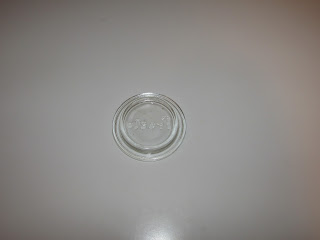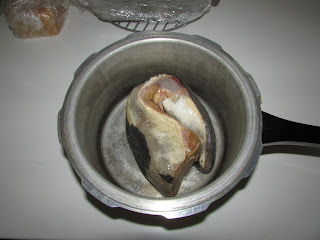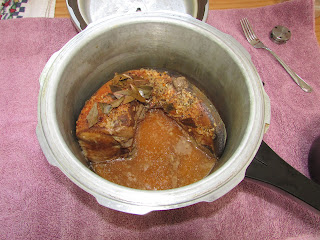However, from what I read online and what I see in stores around here, we are currently in a nationwide shortage of that type of canning lid. Our experiences so far in 2020 have taught us that supply lines can certainly become unreliable, so I think it is anybody's guess as to when canning lids will be readily available again. And surely Nancy and I are not the only people in whose basement rest boxes of antique canning supplies which have been passed down from generation to generation simply because no one took the time to throw them out!
Now, part of this blog's purpose is the preservation of the nearly lost skill of cooking on a woodburning cookstove, and let's be honest: its tone is unmistakeable. I am a huge proponent of using wood cookstoves.
This post is different, though. This is not a ringing endorsement for the use of glass canning lids; it is merely an educational post so that information about another nearly lost skill is out there and available for others. I'm afraid it could come in quite handy in the near future.
Enough with the disclaimers and onto the meat of the post:
The data that I'm going to share with you comes from my 1937 Ball Blue Book, my 1946 Kerr Canning Home Canning manual, and my 1953 Ball Blue Book. While I wouldn't consider the canning time tables and the instructions for oven and open kettle canning pertinent anymore, the information on how to operate the canning hardware itself is still accurate for these vintage lids.
The equipment that you will need is unique to this type of jar closure. Of course, the first necessity is the actual glass lid itself. To be clear, there were two types of glass canning lid marketed in the first half of the twentieth century. One type was for the bail-type jars and had a niche in the top in order to accommodate the upper wire bail which held it in place. These are larger in diameter and have a convex shape.
The lids that I'm talking about here are the same diameter as today's dome lids and fit over the opening of the jar just like they do. They have a lip on the bottom side which fits down inside the jar.
 |
| A picture of a Presto brand glass canning lid. |
These lids can only be used with metal bands that are specifically made for them. I have two different styles of bands; one has the hour-glass shaped opening in the top, and the other looks like a standard canning jar ring.
The picture below is of a canning ring for glass lids on the left and a standard ring for dome lids on the right. You can see that the ring for the glass lids is taller than what is used today. That is because the glass lid and the rubber ring are much taller than the sealing edge that a dome lid has.
To use glass lids, you also have to have a "top-seal" rubber ring. These are entirely different than the rubber rings that are used with the old zinc canning lids; they are smaller in diameter and never have a tab.
When you are going to use them for canning, the rings must be softened and hydrated. This is accomplished by scalding them and leaving them in hot water until you are ready to put them on the jar. You can also boil them for five minutes.
Once your jars are packed with the food to be canned, fit the rubber ring around the outside of the bottom of the glass lid.
Place the lid and rubber ring on the top of the jar.
The next step is to screw the ring onto the jar firmly tight. Then unscrew the ring one quarter inch.
Process the food in whatever method you would ordinarily use for what you are canning. In these pictures, I was canning Grammer's Sweet Pickles ("Grammer" is our name for my paternal great-grandmother who was the first woman to live in our house).
At the end of the processing time, remove the jar from the canner and set it on a towel.
Immediately tighten the ring that quarter of an inch that you backed it off before processing.
After the jar is completely cooled, you can check whether the jar has sealed by lifting the jar by the glass lid. If you can lift it by the lid only, the jar is sealed.
To open the jar, insert the tip of a paring knife between the rubber ring and the lip of the jar.
I've read that glass lids are still popular with some home canners for extremely high acid foods like pickles because the food doesn't touch any metal.
Obviously, this kind of canning lid can be reused indefinitely. Vintage instructions indicate that new rubber rings should be used, but rings were very often used multiple times. I have used both new (unused old stock) and used rings with equal success so far. I don't know whether the rubber rings available for use with the new Tattler lids would work for this type of lid, but I suspect not, due to the fact that their width is not the same.
One can usually purchase new old stock rubber rings on Ebay. Be sure that they are labeled "Top Seal." Common brands are Top Flite, Ball, Cuppers, and Bulldog.
Again, this is not a recommendation to use this type of lid, but who knows what skills we may need to revive in the future?
Let me know in the comments what you think. Have you used this type of lid before? Should I write a post about using the old zinc lids too?
Be safe, everyone!











































